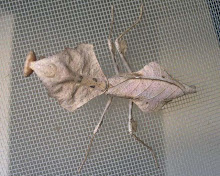When threatened, praying mantids stand tall and spread their forelegs to allow them to penetrate the target, with their wings fanning out wide and mouths open. The fanning of the wings is used to make the mantis seem larger and to scare the opponent, with some species having bright colors and patterns on their hind wings and inner surfaces of their front legs for this purpose. If harassment persists, the mantis will then strike with their forelegs and attempt to pinch or bite.
Mantids do not develop wings until the final molt. Some mantids do not develop wings at all, or may have small flightless wings. The only time mantids fly is when the adult female begins to emit pheromones which attract males for mating. Contrary to popular belief, not all males become the meal of the female. Male mantids fly at night as they seem to be attracted to artificial lights. Bats, one of the mantid's natural predators, feed at night when the males are busy locating a mate. Bats, as you may know, use echolocation to pinpoint their prey. According to Yager and May, praying mantids are able to hear these sounds and when the frequency begins to increase rapidly, indicating an approaching bat, mantids will stop flying horizontally and begin a descending spiral toward the safety of the ground. Often this descent will be preceded by an aerial loop or spin. Other times, the entire descent will consist of a downward spiral. The mantis has one single ear, its sole purpose being for the detection of bats.
.jpg)
.jpg)
.jpg)